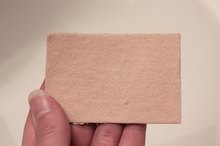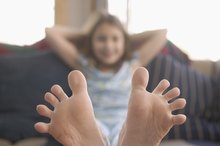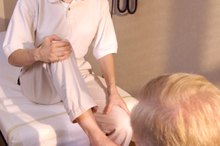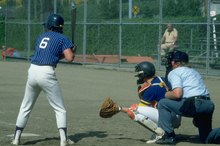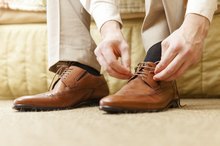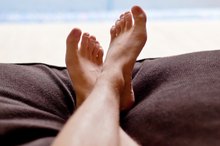How to Cure Athlete's Foot and Really Bad Blisters
Athlete's foot, also known as tinea pedis, is one of the most common forms of foot fungus. The fungus occurs on sweaty, moist feet that have not been properly cleaned. Blisters can occur on your feet when there is too much friction between a spot on your foot and your shoe. Blisters usually happen to people who are not used to some form of physical activity. Both athlete's foot and blisters can be annoying and painful. However, there are ways to help heal and cure athlete's foot and blisters.
Athlete's Foot Cures
Spray your feet after showering with rubbing alcohol. and let the feet air dry or towel dry. The alcohol with help dissolve the water on your feet and prevent the fungus from spreading to other areas on your feet.
How to Use Moleskin for Blisters
Learn More
Eat a lot of yogurt or take a vitamin B supplement several times a day if you are taking some form of antibiotics for another ailment. Antibiotics destroy the good bacteria along with the bad bacteria, which can make it difficult to heal athlete's foot.
Put some medicated foot powder or some baking soda in your shoes. This will help keep your feet dry. This will keep the moisture away and prevent any new fungus from forming on the foot.
What Can Cause Sudden & Severe Itchy Feet in a Child?
Learn More
Make a mixture of 50 percent apple cider vinegar and 50 percent water. Soak your feet in the water for 10 minutes a day for up to 10 days. This will help prevent the itchiness of athlete's foot and will help peel the upper layer of fungus on your feet off.
- Spray your feet after showering with rubbing alcohol.
- The alcohol with help dissolve the water on your feet and prevent the fungus from spreading to other areas on your feet.
Cure Blisters On Your Feet
Drain the fluid from large blisters on the feet by draining it with a sterilized needle. Prick it with the needle, and slowly let the fluid drain out. Put a bit of antibiotic ointment on the area. Cover it with a bandage to make sure the blister does not become infected.
Remove the the bandage from the blister every few days. Try soaking the area in water, and leave it uncovered when you go to bed to help it heal faster.
Powder your feet daily with baby powder before putting your socks and shoes on every day. This will help prevent any new blisters from forming by creating less friction between the feet, socks and shoes.
Tips
Avoid itching and scratching your feet with athlete's foot as this can spread the fungus to other areas of the foot.
Warnings
Consult your doctor for medical advice before you begin any sort of self-treatment.
- Drain the fluid from large blisters on the feet by draining it with a sterilized needle.
Related Articles
References
- American Academy of Dermatology. How to prevent and treat blisters.
- Hoffman MD. Etiological foundation for practical strategies to prevent exercise-related foot blisters. Curr Sports Med Rep. 2016;15(5):330-5. doi:10.1249/JSR.0000000000000297
- Caselli MA, Chen-Vitulli J. Foot blister prevention: What you can recommend to athletes. Podiatry Today. 2002;15(4):68-69.
- Mailler EA, Adams BB. The wear and tear of 26.2: dermatological injuries reported on marathon day. Br J Sports Med. 2004;38(4):498-501. doi:10.1136/bjsm.2004.011874
- Worthing RM, Percy RL, Joslin JD. Prevention of friction blisters in outdoor pursuits: A systematic review. Wilderness Environ Med. 2017;28(2):139-149. doi:10.1016/j.wem.2017.03.007
- Abd Elmegeed AS, Ouf SA, Moussa TA, Eltahlawi SM. Dermatophytes and other associated fungi in patients attending to some hospitals in Egypt. Braz J Microbiol. 2015;46(3):799–805. doi:10.1590/S1517-838246320140615
- Homei A, Worboys M. Fungal Disease in Britain and the United States 1850–2000: Mycoses and Modernity. Basingstoke (UK): Palgrave Macmillan; 2013. Chapter 2, Athlete’s Foot: A Disease of Fitness and Hygiene.
- InformedHealth.org [Internet]. Cologne, Germany: Institute for Quality and Efficiency in Health Care (IQWiG); 2006-. Nail fungus: Overview. 2015 Jan 14 [Updated 2018 Jun 14].
- InformedHealth.org [Internet]. Cologne, Germany: Institute for Quality and Efficiency in Health Care (IQWiG); 2006-. Athlete's foot: Overview. 2015 Jan 14 [Updated 2018 Jun 14].
- Nigam PK, Saleh D. Tinea Pedis. [Updated 2019 Nov 25]. In: StatPearls [Internet]. Treasure Island (FL): StatPearls Publishing; 2019 Jan-.
- Leyden JJ, Kligman AM. Interdigital athlete's foot: new concepts in pathogenesis. Postgrad Med. 1977;61(6):113-6.
- Blutfield MS, Lohre JM, Pawich DA, Vlahovic TC. The Immunologic Response to Trichophyton Rubrum in Lower Extremity Fungal Infections. J Fungi (Basel). 2015;1(2):130–137. doi:10.3390/jof1020130
- Al Hasan M, Fitzgerald SM, Saoudian M, Krishnaswamy G. Dermatology for the practicing allergist: Tinea pedis and its complications. Clin Mol Allergy. 2004;2(1):5. Published 2004 Mar 29. doi:10.1186/1476-7961-2-5
- Chollet A, Cattin V, Fratti M, Mignon B, Monod M. Which Fungus Originally was Trichophyton mentagrophytes? Historical Review and Illustration by a Clinical Case. Mycopathologia. 2015;180(1-2):1-5. doi:10.1007/s11046-015-9893-2
- Newland JG, Abdel-Rahman SM. Update on terbinafine with a focus on dermatophytoses. Clin Cosmet Investig Dermatol. 2009;2:49–63. Published 2009 Apr 21. doi:10.2147/ccid.s3690
- Hainer BL. Dermatophyte infections. Am Fam Physician. 2003;67(1):101-8.
- Jimenez-garcia L, Celis-aguilar E, Díaz-pavón G, et al. Efficacy of topical clotrimazole vs. topical tolnaftate in the treatment of otomycosis. A randomized controlled clinical trial. Braz J Otorhinolaryngol. 2019.
- Lestner J, Hope WW. Itraconazole: an update on pharmacology and clinical use for treatment of invasive and allergic fungal infections. Expert Opin Drug Metab Toxicol. 2013;9(7):911-26.
Writer Bio
Based in New Hampshire, Ted Gulezian has been writing professionally since 2007. He specializes in writing health- and fitness-related articles and has been published on eHow and LIVESTRONG.COM. Gulezian has a bachelor's degree in athletic training from the University of New Hampshire.
